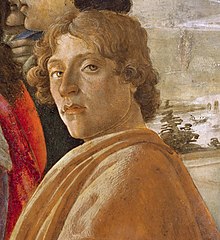Cinquecentist
Appearance
See also: cinquecentist
English
[edit]Alternative forms
[edit]Etymology
[edit]
From Italian cinquecentista (“Cinquecentist”), from cinquecento (“sixteenth century”) + -ista (“-ist, suffix indicating a person with a particular creative or academic role”); compare French cinquecentiste.
Pronunciation
[edit]- (Received Pronunciation) IPA(key): /tʃiŋkwɛˈtʃɛntɪst/
Audio (Southern England): (file) - (General American) IPA(key): /t͡ʃiŋkwəˈt͡ʃɛntɪst/, /-ɾɪst/
- Hyphenation: Cin‧que‧cent‧ist
Adjective
[edit]Cinquecentist (not comparable)
- Of or pertaining to the art of Italy in the sixteenth century.
- 1828, A[ugustus] B[ozzi] Granville, “Saxony, Prussia, Federated States, and France”, in St. Petersburgh. A Journal of Travels to and from that Capital; through Flanders, the Rhenish Provinces, Prussia, Russia, Poland, Silesia, Saxony, the Federated States of Germany, and France. [...] In Two Volumes, volume II, London: Henry Colburn, New Burlington Street, →OCLC, page 654:
- Its [Dresden's] stately and cinquecentist mansions bring back interesting recollections; its treasures of art make us proud of humanity; and the rich and picturesque scenery of its environs add surprise to our delights.
- 1891, James Fergusson, Robert Kerr, “Secular Architecture”, in History of the Modern Styles of Architecture: [...] In Two Volumes, 3rd rev. edition, volume I, London: John Murray, Albemarle Street, →OCLC, book I (Italy), page 36:
- Suffice it to say as a last word that the ancient Romans, the cinquecentist Italians, and the modern Europeans, obviously form in architectural history one continuous dynasty.
- 2009, Heinrich Wölfflin, “Principles of Art History”, in Donald Preziosi, editor, The Art of Art History: A Critical Anthology (Oxford History of Art), 2nd edition, Oxford: Oxford University Press, →ISBN, page 127:
- Whenever we pass from the Cinquecentist room in a gallery to the baroque, the surprise we feel is that clear, obvious juxtaposition ceases and that colours seem to rest on a common ground in which they sometimes sink into almost complete monochrome, in which, however, if they stand out clearly, they remain mysteriously moored.
Noun
[edit]Cinquecentist (plural Cinquecentists)
- An Italian of the sixteenth century, especially a poet or an artist.
- 1891, James Fergusson, Robert Kerr, “Secular Architecture”, in History of the Modern Styles of Architecture: [...] In Two Volumes, 3rd rev. edition, volume I, London: John Murray, Albemarle Street, →OCLC, book I (Italy), page 169:
- As a matter of good sense alone, it must sooner or later become clear to the mind of anyone that the Cinque-centists, on their own Italian ground teeming with relics of the past, and in the exhilarating intellectual air of their great philosophical revolution, enjoyed a truly grand architectural opportunity.
- A student or imitator of the art or literature of that period.
- The style of art or architecture of that period.
- 1864, Robert Kerr, “Palladian Style”, in The Gentleman's House; or, How to Plan English Residences, from the Parsonage to the Palace; with Tables of Accommodation and Cost, and a Series of Selected Plans, London: John Murray, Albemarle Street, →OCLC, part IV (Notes on Architectural Style), page 364:
- The style at large, called the Cinquecentist (that is, of the fifth—for fifteenth—century), or the Italian (because of its birthplace), or the modern or revived Classic (being the academical antique), is primarily based upon the columnar system of the Greeks, received by them historically from the East, and transmitted historically Westward (on the tide of empire) to Rome.
Translations
[edit]Italian of the sixteenth century
|
Further reading
[edit] Cinquecento on Wikipedia.Wikipedia
Cinquecento on Wikipedia.Wikipedia
Categories:
- English terms derived from Italian
- English 4-syllable words
- English terms with IPA pronunciation
- English terms with audio pronunciation
- English lemmas
- English adjectives
- English uncomparable adjectives
- English terms with quotations
- English nouns
- English countable nouns
- English terms suffixed with -ist
- en:Art
- en:Italy
- en:People
